Manufacturers of the Boston-Edison Historic District
Frank H. Alfred
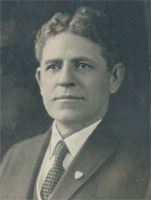 Frank H. Alfred was born in Ohio in 1866. He attended both Ohio State University and the University of Michigan. He spent 12 years in the railroad industry in Ohio, then joined the Pere Marquette Railroad as a civil engineer in 1901. He was soon the company's chief engineer, then general manager. He served as both president and general manager of Pere Marquette from 1917 to 1929, when he retired. Alfred was also active in the city, serving as a member Detroit School Board from 1916-1922, finishing out his term as the body's president. He died in 1947.
Frank H. Alfred was born in Ohio in 1866. He attended both Ohio State University and the University of Michigan. He spent 12 years in the railroad industry in Ohio, then joined the Pere Marquette Railroad as a civil engineer in 1901. He was soon the company's chief engineer, then general manager. He served as both president and general manager of Pere Marquette from 1917 to 1929, when he retired. Alfred was also active in the city, serving as a member Detroit School Board from 1916-1922, finishing out his term as the body's president. He died in 1947.
Frank H. Alfred lived at 1422 Longfellow in the 1920s and 1930s.
Lewis Burton Alger
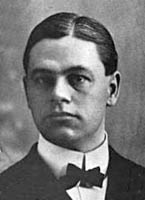
Lewis Alger was born in Elyria OH in 1873. His family moved to St Joseph; he then attended Albion Chllege and the University of Michigan; he graduated with a Bachelor of Philosophy in 1897. He was superintendant af schools in Gaylord and Nashville Michigan, then attended Columbia to receive his Master of Arts. He was principal of the state Normal School in Washington, then returned to the University of Michigan to becone a Junior Professor of pedagogy for two years. He left U of M to go into business, founding the Detroit Soda Company, which made baking soda, as well as water softeners and borax. The Detroit Soda plant was located in Wyandotte.
Lewis Burton Alger lived at 1602 Edison in the early 1920s.
Albert E. Badger
Albert E. Badger was born in Detroit in 1880. His father was the first lighthouse keeper of the Belle Isle lighthouse and was later stationed in Grosse Pointe. Albert was educated in Grosse Pointe and Detroit, and attended the Detroit Business University. After graduation, he joined the Pere Marquette railroad as a clerk in 1899. He worked his way up the ladder at the company, becoming a stenographer, then advancing to positions in the engineering, operating, and executive departments. He was promoted to assistant to the President, and then to General Superintendent of the company.
Albert E. Badger lived at 1986 W. Boston Boulevard in the 1930s and moved to 1901 W. Boston, where he lived until his death in 1942.
Harry H. Berger
Harry H. Berger was born in 1872. When he was 17, he moved from Detroit to the lumber town of Alpena, where he started as a tally boy, recording each piece of timber as it was readied for shipment. There, he met Frederick M. Sibley, and in 1896 the two men founded the Frederick M. Sibley Lumber Company, with Sibley as president and Berger as secretary-treasurer. Berger soon moved back to Detroit, and in 1916 married Amy Rosengarten, whose parents lived at 862 Chicago. In 1924, the couple built a new home at 830 W. Boston. Berger continued as secretary-treasurer of the firm for 58 years, until his retirement in 1954.
Harry and Amy Bergen lived at 830 W. Boston from 1924 until his death in 1956 and hers in 1973.
William Edouard Besancon
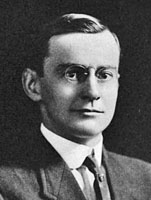
William Besancon was born in 1877 in Detroit. His father and mother were both natives of France who had emigrated to Detroit in the middle of the 19th century. William was educated in Detroit and attended the University of Michigan for two years, after which he tried his hand at various business pursuits. In 1901, he founded a coalyard bearing his name, which he built to become one of the largest in the city.
William Edouard Besancon lived at 932 Edison in the late 1910s and 1920s, then moved to 1456 W. Boston Boulevard, where he lived until the late 1940s.
Charles B. Bohn
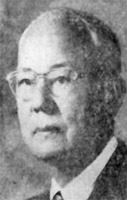 Charles B. Bohn was born in 1880 in Toledo OH. In 1897, he began working as a bookkeeper at a small brass works, where he picked up knowledge of the trade. In 1900, he left to found the Allyne Brass Company with three partners. The new firm began experimenting with aluminum production, until then difficult to work with, and was the first to offer commercial aluminum castings. In 1918, Bohn organized the Charles B. Bohn Foundry in Detroit (buying Max Stotter's smelting firm in the process), which furnished aluminum castings for the "Liberty" airplane engines of WWI. The company was reorganized in 1923 as Bohn Aluminum and Brass.
Charles B. Bohn was born in 1880 in Toledo OH. In 1897, he began working as a bookkeeper at a small brass works, where he picked up knowledge of the trade. In 1900, he left to found the Allyne Brass Company with three partners. The new firm began experimenting with aluminum production, until then difficult to work with, and was the first to offer commercial aluminum castings. In 1918, Bohn organized the Charles B. Bohn Foundry in Detroit (buying Max Stotter's smelting firm in the process), which furnished aluminum castings for the "Liberty" airplane engines of WWI. The company was reorganized in 1923 as Bohn Aluminum and Brass.
Bohn also was a director of Michigan National Bank and the Wolverine Insurance Company, and owned a horse racing stable, the Bomar Stables. Charles Bohn continued to lead Bohn Aluminum and Brass until his death in 1953.
Charles B. Bohn lived at 1169 W. Boston in the early 1920s.
Albert E. Charlesworth
Albert E. Charlesworth was born in 1869 in Leicester, England. His family soon emigrated to Toronto, where Albert was educated. He came to Detroit in 1882 at the age of thirteen, and went to work for the Johnston Optical Company two years later. In 1898 he left to found his own company, the Charlesworth Optical Company. In 1912, Charlesworth merged with the Kennedy and Wolverine Optical Companies to form a new Wolverine Optical, of which Charlesworth was president.
Albert E. Charlesworth lived at 1200 Longfellow from the 1910s through the early 1940s.
Emerson Davis
Emerson Davis was born in 1878 in Bay City, where his father, John, owned a drugstore. John Davis later moved to Detroit and established the Detroit Chemical Works in 1888; the company manufactures suphate of ammonia, sulphuric acid, and nitric acid. Emerson attended the Detroit Public Schools and the University of Michigan, graduating in 1901. He immediately joined his father's business as Treasurer. In 1906, Davis married Marian Biegler; the couple had four children. Davis later succeeded his father as president of Detroit Chemical Works.
Emerson Davis lived at 1973 Edison in the 1920s and 1930s.
John Davis
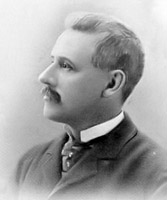
John Davis was born in 1844 in Massachusetts, where he also attended school. He served in the Civil War, first as an infantryman and then in the medical corps. In 1867, he began in business as a druggist, and the next year moved to Bay City, Michigan, where he opened his own drug store. In 1870, John Davis married Ida M. Hitchcock; the couple had three sons: Edward, John, and Emerson. In 1879, Davis began manufacturing specialties for grocers, such as baking powder, condiments, and extracts. He later moved to Detroit and in 1888 established the Detroit Chemical Works, a manufacturer of sulfate of ammonia, sulfuric acid, and nitric acid.
John Davis lived at 151 Longfellow in the 1920s.
Perry Feigenson
In 1907, Perry Feigenson and his brother Ben, immigrants from Russia, founded the Feigenson Brothers Bottling Works. Trained as bakers, the Feigensons used cake frosting flavors, such as strawberry, fruit punch, and grape, in their beverages. The business slowly grew, and the brothers added new flavors and employees. In 1921, they changed the name to "Faygo" because it fit more easily on the bottles. The company continued to grow, and in late 1930s and early 1940s Ben and Perry's sons entered the firm. In the mid-1940s, Perry and Ben Feigenson turned Faygo over to their children.
Perry Feigenson lived in the house at 2247 W. Boston Boulevard during the 1940s.
Charles E. Feinberg
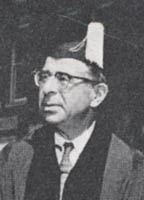
Charles Feinberg was born in England in 1900 and moved to America at the age of 23. He obtained managerial positions at Detroit's Regal Shoe Company and Silent Automatic Corporation before moving to Argo Oil, where he was vice president for 23 years and president for seven. He ended his career as vice president of the Speedway Petroleum Corporation.
Feinberg was an avid collector of materials related to James Joyce, Walt Whitman and other modern American and English authors. He donated portions of his collection to Albion College, Southern Illinois University, the University of Texas, and Louisiana Tech, and supplied an important collection of Walt Whitman papers to the Library of Congress.
Feinberg resided in two homes in Boston-Edison: 2215 W. Boston in the late 1930s (later occupied by Dr. Robert C. Bennett) and 872 W. Boston (the house built by Frank C. Teal) from the late 1940s through the 1970s.
Read Charles Feinberg's biography and obituary in the New York Times.
George W. Heigho
George Heigho was born in 1862 in Essex, England. The family moved to the United States in 1874, first settling in Trenton, MI, then moving to Detroit. George Heigho entered business with the Detroit Stove Works, and moved to other companies before, in 1881, starting as a clerk at the Calvert Lithographing Company. Calvert Lithographing was founded in 1863, and by 1890 was one of the largest lithography companies in the United States, employing over 100 people. Heigho worked his way up in the company, was was made secretary-treasurer in 1900, and assumed the presidency in 1910.
George W. Heigho lived at 1180 Chicago Boulevard (now demolished) from the late 1910s through the early 1940s.
Henry P. Hellmuth
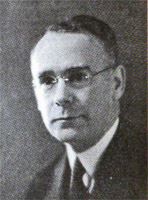 Henry P. Hellmuth's career was in marine engine sales. He started in 1902 in the sales department of Smalley Motor Company of Bay City, and in 1908 moved to Detroit to become sales manager at the Grey Motor Company. In 1915, he moved to the Scripps Motor Company, where he was sales manager and secretary/treasurer of the company. He stayed there until 1928, when he left to become secretary of the Hacker Boat Company. In 1933, he moved on to become sales manager of the Kermath Manufacturing Company, another Detroit-based marine engine manufacturer. He ended his career there as vice-president of the company.
Henry P. Hellmuth's career was in marine engine sales. He started in 1902 in the sales department of Smalley Motor Company of Bay City, and in 1908 moved to Detroit to become sales manager at the Grey Motor Company. In 1915, he moved to the Scripps Motor Company, where he was sales manager and secretary/treasurer of the company. He stayed there until 1928, when he left to become secretary of the Hacker Boat Company. In 1933, he moved on to become sales manager of the Kermath Manufacturing Company, another Detroit-based marine engine manufacturer. He ended his career there as vice-president of the company.
Henry P. Hellmuth lived at 2437 Longfellow in the 1920s.
William Davis McCullough

William D. McCullough was born in Detroit in 1886. His father died when McCullough was at a young age, and he was forced to fend for himself, driving a delivery wagon. In 1901, he headed west and spent time on a cattle ranch. In 1903, he moved to Indianapolis, and two years later to New York. He became a salesman for the Motor Parts Corporation of New York, and in 1910 returned to Detroit, where he became a purchasing agent for Cadillac. He next moved to Detroit Wire Spring, and in 1915 organized his own company, the Premier Cushion Spring Co. During World War I, McCullough organized the Premier Machine Company, and supplied parts to Dodge and Ford.
William D. McCullough lived at 1115 West Boston in the 1920s and 1930s.
John Riccardi
John Riccardi was born in Italy in 1882 and came to the US in 1903 with little money to his name. He moved to Detroit in 1910 and worked as a grocery clerk for two years, after which he opened his own grocery. In 1918, he perfected a household cleanser, and in 1919 he founded the Roman Cleanser Company, the first to introduce household bleach to the United States. This enabled him to become the largest producer of the product. He remained head of the firm until 1961.
John Riccardi lived at 640 Chicago Boulevard from the late 1930s until his death in 1965.
Bernard Schwartz

Bernard Schwartz was born in Poland in 1872. At the age of 14, he emigrated to Quebec and began work as an apprentice cigar maker. In 1888, he moved again, to Detroit. He worked as a cigar maker for a number of years until, in 1895, Schwartz had accumulated enough capital to open his own cigar manufacturing firm. The Bernard Schwartz Cigar Corporation was immediately a success, ultimately employing over 400 people. The company produced multiple brands, including the popular R.G. Dun cigars (still manufactured by the National Cigar Corporation in Indiana). The Bernard Schwartz Cigar Corporation merged with DWG Cigar Corporation in 1929.
Bernard Schwartz lived at 1448 Longfellow in the 1920s.
Ruluff R. Sterling
Ruluff R. Sterling was born in 1858 in Wayne County. After receiving his education, he worked in retail in Ypsilanti and Escanaba until 1898, when he came to Detroit. In 1902, with Edward J Roney and Frederick G. Skinner, he organized the Sterling & Skinner Manufacturing company, a maker of brass parts for steam and water systems, as well as automobiles. Sterling was president of the company, and later simultaneously became vice-president of Detroit Motor Casting Company. In 1892, Sterling married Sarah A. Thomas; the couple had one daughter, Ruth.
Ruluff R. Sterling lived at 873 W. Boston Boulevard (later the home of Cash W. Talbot) in the 1910s and early 1920s.
Max Stotter
 Max Stotter was born in Minnesota in 1882. His family moved to Cleveland, and in his teens Stotter worked as a salesman. In 1903, he founded the Lake Erie Smelting and Refining Company. He ran this company until 1908, when he joined the Peerless Auto Manufacturing firm. In 1911, he established another smelting company in Cleveland, but the next year he moved to Detroit, where in 1913 he established the Peninsular Smelting and Refining Company. He ran this until 1918, when it was consolidated into the Charles B. Bohn Foundry. Stotter then turned to real estate, investing in properties in Detroit.
Max Stotter was born in Minnesota in 1882. His family moved to Cleveland, and in his teens Stotter worked as a salesman. In 1903, he founded the Lake Erie Smelting and Refining Company. He ran this company until 1908, when he joined the Peerless Auto Manufacturing firm. In 1911, he established another smelting company in Cleveland, but the next year he moved to Detroit, where in 1913 he established the Peninsular Smelting and Refining Company. He ran this until 1918, when it was consolidated into the Charles B. Bohn Foundry. Stotter then turned to real estate, investing in properties in Detroit.
Max Stotter lived at 640 Chicago in the early 1920s.
Cash W. Talbot
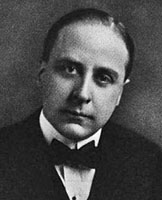
Cash Talbot was born in Toledo in 1884. His family moved to Detroit; after finishing high school, he entered the banking business. After two years, he decided to enter business on his own, and organized the Talbot Coal Company in 1906, with his brothers Fred and Charles as directors. Ten years later, Talbot added lumber to the business; the move made the business more profitable.
Cash W. Talbot lived at 873 W. Boston Boulevard (the home built by Ruluff R. Sterling) from the late 1920s.
Stuart Wells Utley
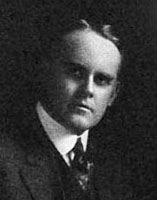
Stuart Wells Utley was born in 1879 Pontiac, Michigan. His family moved to Kansas when he was small, but he returned to Michigan to graduate from Detroit's Central High School. He attended the University of Michigan, graduating in 1902. He began in business at the American Radiator Company, and in 1906 began as a clerk at the Detroit Steel Casting Company. In time, he was promoted to assistant secretary, secretary, vice-president, general manager, and finally president of the company. He was also president of the Detroit Forging Company. Utley was active in the naval Reserve before, during, and after World War II, and wrote extensively on economic subjects.
Stuart Wells Utley lived at 1964 Edison from the early 1920s until the early 1940s.
William J. White
William J. White was born in 1867 in London, England. The family emigrated to Canada in 1874 and to Detroit in the early 1880s. White graduated from high school in 1882, and worked in various businesses until 1890, when he started his own firm specializing in manufacturing color cards for the paint business, W J White & Co. White constructed an automatic machine which would paste colors to sample cards, dramatically cutting the cost of production.
William J. White lived at 1966 W. Boston Boulevard in the 1930s, in the home later occupied by the Hon. Arthur M. Bowman.
Leonard A. Young

Leonard Augustus Young was born in Chicago in 1877. He was educated in the same city, and enlisted in the Army during the Spanish-American War. After his discharge, he started in business selling livestock, but shortly became involved in the spring and rubber business. In 1908, he moved to Jackson, Michigan to manage a spring-making plant, and a short while later obtained interest in what was at the time called the Detroit Wire Spring Company. Young attached himself to the then-infant automotive industry, and by 1912 had built Detroit Wire Spring into the largest in the industry. He later renamed it after himself: L. A. Young Spring & Wire. Young branched into other businesses, including the L. A. Young Golf Company, which made golf equipment and kept golfer Walter Hagen on the payroll; and Tiffany Productions, a Hollywood movie studio.
In 1907, Young married Ola Butcher. After Young's death, the Young Spring & Wire Company changed hands multiple times; a single plant in Archbold, OH still operates as a division of Leggett & Platt.
Leonard A. Young lived at 918 W. Boston Boulevard during the 1930s and 1940s, in the home built by Nels Michelson (and where Berry Gordy, Jr. lived later); Young built the Athletic outbuilding that still stands on the grounds.

